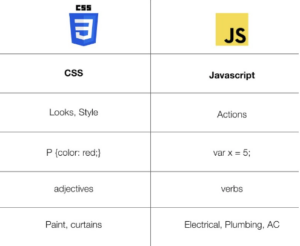CSS (Cascading Style Sheets) and JavaScript are two fundamental technologies that play distinct yet complementary roles in web development. CSS is primarily responsible for styling and layout, determining the visual presentation of web content, while JavaScript focuses on enhancing interactivity and dynamic functionality. In this article, we’ll delve into the key differences between CSS and JavaScript, unraveling their unique contributions to the web development process.
Purpose and Functionality
The fundamental difference lies in the purpose and functionality of CSS and JavaScript. CSS is a style sheet language used for describing the look and formatting of a document written in HTML. It controls the layout, colors, fonts, and other visual aspects, ensuring a consistent and visually appealing presentation. On the other hand, JavaScript is a scripting language that adds interactivity and dynamic behavior to web pages. It enables developers to create responsive, real-time interactions, validate forms, manipulate the DOM (Document Object Model), and handle asynchronous operations.

Styling vs. Scripting
CSS primarily focuses on styling and layout, empowering developers to specify the visual presentation of elements on a web page. This includes aspects like colors, fonts, spacing, and responsive design. In contrast, JavaScript is a scripting language used for scripting behaviors and actions within a web page. It enables developers to create interactive elements, respond to user actions, and dynamically update content without requiring a page reload.
Separation of Concerns
A key principle in web development is the separation of concerns, and CSS and JavaScript adhere to this principle in different domains. CSS is responsible for the presentation layer, ensuring a clean separation from the HTML structure. This separation allows for easier maintenance, scalability, and the ability to change the visual aspects of a website without altering its underlying structure. JavaScript, while often embedded in HTML, focuses on enhancing the behavior and functionality of a web page, providing a clear distinction between content, presentation, and behavior.
Syntax and Structure
Moreover, CSS and JavaScript have distinct syntax and structures tailored to their specific roles. CSS employs a declarative syntax, where developers define styles for HTML elements using property-value pairs. The style rules are then applied based on selectors. In contrast, JavaScript uses an imperative syntax, allowing developers to write scripts that explicitly state the sequence of actions to be executed. JavaScript utilizes functions, variables, and control structures to achieve dynamic behavior and interactivity.
Execution Time
CSS applies styles to HTML elements as the browser parses the document in the rendering phase, ensuring prompt visual presentation. In contrast, JavaScript usually executes after the HTML and CSS load. It can manipulate the DOM dynamically, responding to user interactions or events, and modify the content or behavior of the page in real-time.
Browser Rendering
Furthermore, CSS is a critical component of the initial rendering process, contributing to the visual display of a web page. Its application is synchronous with the rendering engine, ensuring that styles are applied progressively as the HTML document is parsed. JavaScript, however, can impact the rendering process asynchronously. When JavaScript code alters the DOM or initiates asynchronous tasks, it may lead to delays in rendering, influencing the user experience. Optimizing the execution of JavaScript becomes crucial for maintaining a responsive and smooth user interface.
Conclusion
In the intricate tapestry of web development, CSS and JavaScript are integral threads that contribute to the overall user experience. CSS shapes the visual presentation and layout, ensuring a polished and aesthetically pleasing design. JavaScript, on the other hand, adds dynamism and interactivity, making web pages responsive and engaging. Understanding the distinctions between CSS and JavaScript is essential for developers, as it empowers them to leverage each technology effectively and create web experiences that seamlessly blend style and functionality.

